iRobot Bundle
Can iRobot Rebound?
iRobot, the robotics company behind the iconic Roomba, has revolutionized home cleaning. For years, the company has been a leader in the robot vacuum market, but recent financial results reveal a challenging landscape. Understanding iRobot SWOT Analysis is crucial to assess its potential for recovery and growth.
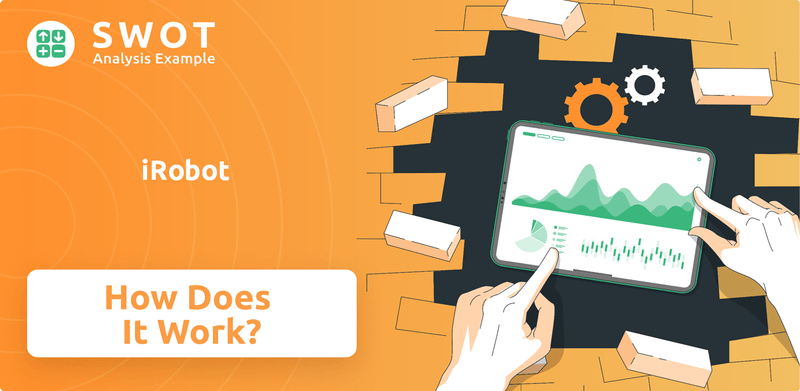
This exploration of How iRobot works will delve into the company's operations, revenue streams, and strategic responses to market dynamics. Despite a decrease in revenue, iRobot is actively adapting through restructuring and product innovation. This analysis is vital for investors and anyone interested in the future of this robotics company and its impact on the smart home sector, including how the iRobot Roomba navigates a room and its features.
What Are the Key Operations Driving iRobot’s Success?
The iRobot company primarily focuses on designing, developing, and selling consumer robots. Its core products, such as the Roomba robotic vacuum cleaners and Braava robotic mops, are designed to automate household chores. This approach caters to a broad customer base, including homeowners, tech enthusiasts, and busy professionals, all seeking convenience and efficiency in their daily lives.
The value proposition of the iRobot lies in its ability to provide efficient and effective cleaning solutions. These solutions save customers time and effort. This focus on customer needs is a key driver for the company's market presence. The company's operations are designed to support this value proposition through continuous innovation and a customer-centric approach.
The operational processes of iRobot involve significant investments in research and development (R&D), manufacturing, and a robust distribution network. The company allocates approximately 12-14% of its revenue annually to R&D. This investment leads to advancements in machine learning algorithms, navigation systems, and sensor technologies. Its manufacturing facilities are located in Bedford, Massachusetts, and it leverages global contract manufacturing partners. This enables an annual production capacity of 4.2 million robotic units. The supply chain has been transformed, with a focus on streamlining and leveraging partners for non-core engineering functions.
iRobot employs a multi-channel distribution strategy. This includes its official website for direct sales and partnerships with various online and offline retail chains. Strategic collaborations with tech companies such as Amazon and Google also enhance its market reach.
The iRobot Robotic App allows remote control, cleaning schedules, and maintenance alerts. This enhances user experience and fosters brand loyalty. This customer-centric approach, combined with continuous innovation and a diversified product portfolio, translates into significant customer benefits.
iRobot's operations are characterized by a strong emphasis on customer needs and continuous innovation. The company's focus on R&D and strategic partnerships allows it to maintain a competitive edge in the robotics market. The company's approach to manufacturing and distribution ensures that its products are accessible to a wide range of consumers. For more information on the company's structure, consider reading Owners & Shareholders of iRobot.
- R&D Investment: Approximately 12-14% of revenue allocated annually.
- Production Capacity: Up to 4.2 million robotic units per year.
- Distribution Channels: Direct sales, online, and offline retail partnerships.
- Customer Engagement: iRobot Robotic App for enhanced user experience.
iRobot SWOT Analysis
- Complete SWOT Breakdown
- Fully Customizable
- Editable in Excel & Word
- Professional Formatting
- Investor-Ready Format
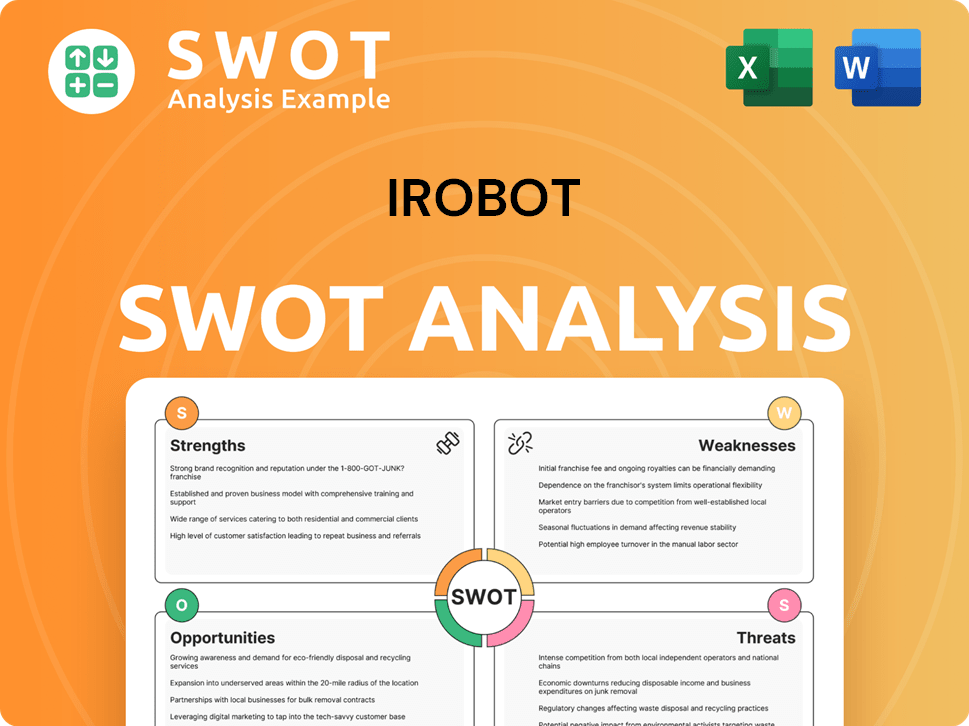
How Does iRobot Make Money?
The iRobot company primarily generates revenue through the sale of its consumer robots, with the Roomba robot vacuum cleaner and Braava mopping robot being its flagship products. In 2022, product sales accounted for approximately 87% of the company's revenue, highlighting the importance of these devices. This focus on product sales is a core aspect of understanding how iRobot works.
Beyond the initial product sales, iRobot also generates substantial revenue from accessories, replacement parts, and related services like maintenance and support. This diversified approach ensures multiple revenue streams, contributing to the company's financial stability. The company continually innovates to maintain its market position within the robotics company sector.
iRobot's monetization strategies extend beyond hardware sales. The company has ventured into software and connectivity features, establishing recurring revenue streams through subscription-based services. Many Roomba models offer Wi-Fi connectivity, providing remote control via smartphone apps or voice assistants. Premium features, such as personalized cleaning schedules and advanced mapping, are offered through subscriptions. For a deeper dive into who uses these products, check out this article about the Target Market of iRobot.
iRobot employs a multifaceted approach to generate revenue and monetize its products and services. This includes direct selling, e-commerce, and niche retail, in addition to product innovation and leveraging technology trends. While specific recent percentages for each revenue stream are not readily available for 2024-2025, the company continues to focus on product sales and the expansion of its software and service offerings. Understanding these strategies is key to grasping the dynamics of the iRobot company.
- Product Sales: The primary revenue source, including Roomba and Braava.
- Accessories and Parts: Sales of replacement parts and accessories.
- Subscription Services: Recurring revenue from premium features and services.
- Direct and Online Sales: Utilizing various sales channels to reach customers.
iRobot PESTLE Analysis
- Covers All 6 PESTLE Categories
- No Research Needed – Save Hours of Work
- Built by Experts, Trusted by Consultants
- Instant Download, Ready to Use
- 100% Editable, Fully Customizable
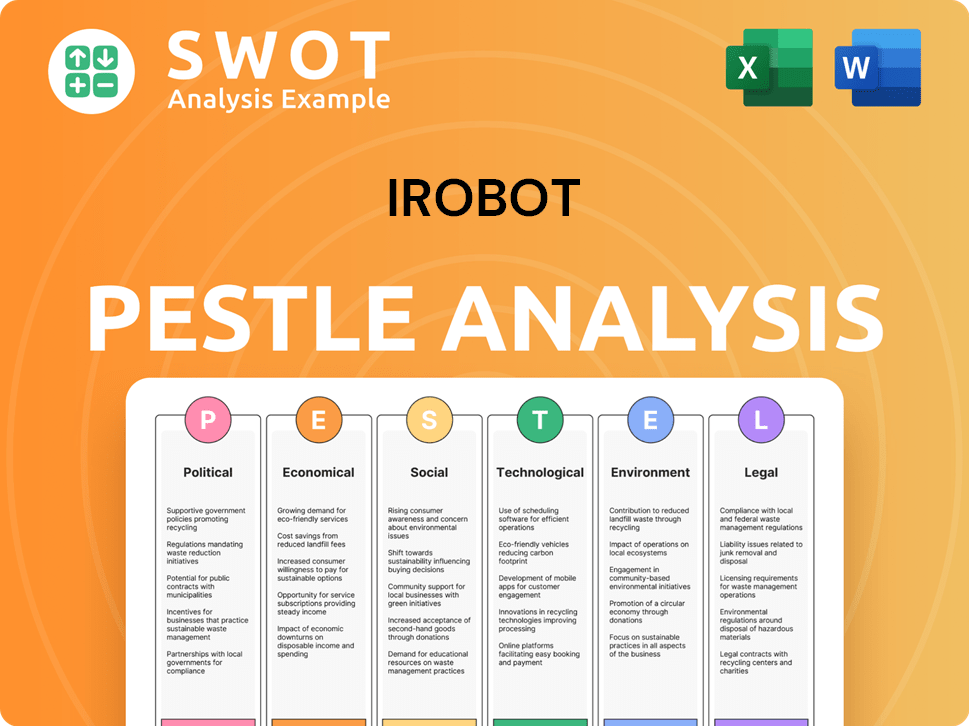
Which Strategic Decisions Have Shaped iRobot’s Business Model?
The iRobot company has experienced significant shifts and strategic maneuvers that have shaped its operational landscape and financial outcomes. A major event was the proposed acquisition by Amazon, valued at $1.4 billion, which was ultimately canceled in January 2024 due to regulatory concerns from the EU. This termination resulted in a $94 million fee for iRobot.
In response to these challenges, iRobot launched a comprehensive restructuring plan in January 2024, known as the 'iRobot Elevate' strategy. This plan involved substantial changes, including a reduction in the workforce by over 50%, aiming to have 541 employees by December 28, 2024. The strategy also included centralizing sales and marketing efforts and optimizing R&D and supply chain models to cut costs and improve gross margins.
In March 2025, iRobot unveiled its largest product launch in company history, introducing new Roomba series models. These new products, like the Roomba Plus 405 Combo Robot + AutoWash Dock and Roomba Plus 505 Combo Robot + AutoWash Dock, are expected to boost margins and support year-over-year revenue growth in 2025. These strategic moves are crucial for the company's future, especially in a competitive market.
The termination of the Amazon acquisition in January 2024 was a pivotal moment, leading to strategic restructuring. The 'iRobot Elevate' plan, initiated in January 2024, aimed to streamline operations and reduce costs. The company focused on optimizing its R&D and supply chain.
The 'iRobot Elevate' strategy involved a significant workforce reduction, aiming for 541 employees by the end of 2024. Centralizing sales and marketing was another key move. The company focused on new product launches like the Roomba Plus 405 and 505 Combo models to drive revenue growth.
iRobot's brand recognition, particularly the Roomba name, is a significant advantage in the robot vacuum market. Consistent investment in R&D keeps the company at the forefront of robotic technology. The company aims to leverage its brand and new product launches with better design and more competitive features.
iRobot faces intense competition from companies like Roborock, Ecovacs Robotics, and others. Chinese manufacturers offer competitive pricing and faster innovation cycles. The company needs to improve its competitiveness through better design and competitive features.
iRobot's competitive edge comes from its strong brand and technological expertise, but it faces challenges from competitors offering lower prices and faster innovation. The company is focusing on new product launches and better design to maintain its position in the market. The company aims to enhance its competitiveness by offering innovative features across different price segments.
- The company is recognized for its brand recognition and technological expertise.
- It faces competition from companies offering competitive pricing and faster innovation.
- iRobot is launching new products with improved design and features.
- The company is aiming to improve its competitiveness across multiple price segments.
iRobot Business Model Canvas
- Complete 9-Block Business Model Canvas
- Effortlessly Communicate Your Business Strategy
- Investor-Ready BMC Format
- 100% Editable and Customizable
- Clear and Structured Layout
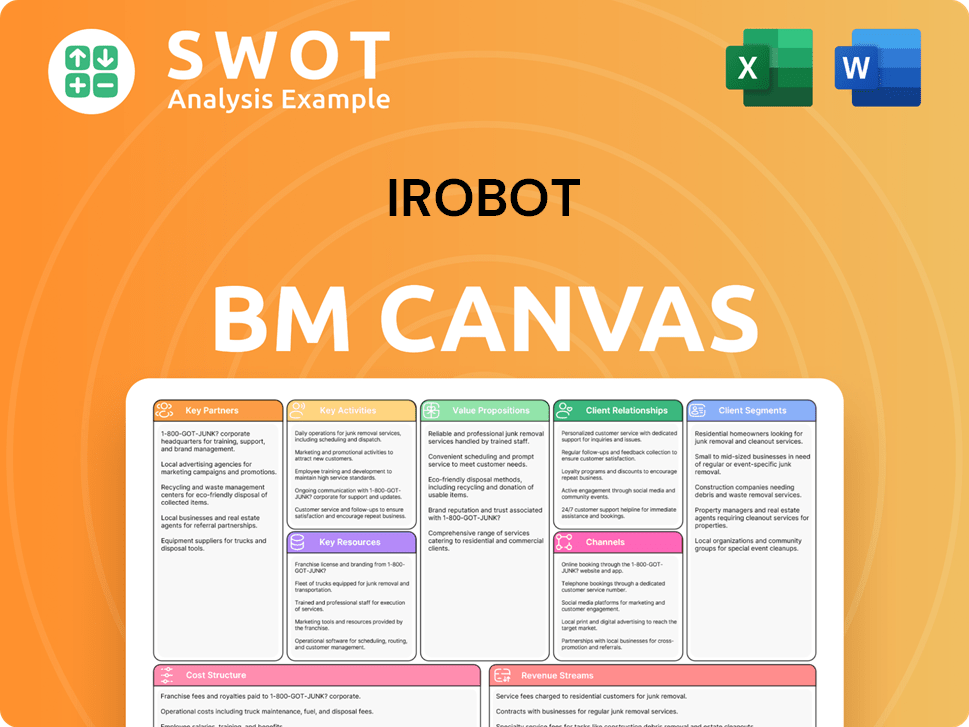
How Is iRobot Positioning Itself for Continued Success?
The iRobot company, a prominent player in the robotics industry, particularly in the robot vacuum cleaner segment, faces a dynamic market environment. Its position is shaped by both its historical achievements and the intensifying competition from other robotics companies. Understanding its industry position, the risks it faces, and its future outlook is crucial for anyone evaluating the company.
As a robotics company, iRobot's performance is influenced by technological advancements, consumer behavior, and broader economic trends. The company's strategic adjustments and market responses are critical to navigating this landscape.
iRobot held a substantial market share in the U.S. robotic vacuum cleaner market, with a 67% share in 2023. However, its global market share decreased to 13.7% in 2024. This shift reflects the growing influence of competitors like Roborock, Ecovacs, and others.
The company faces intense competition, rapid technological advancements, and macroeconomic factors impacting consumer demand. Regulatory changes, particularly concerning data privacy, also present potential risks. The Q4 2024 revenue was affected by increased promotional spending.
iRobot is implementing its 'iRobot Elevate' turnaround strategy, focusing on financial performance and customer-centricity. The company expects to return to year-over-year top-line growth in 2025 with new product launches. The Board is also reviewing strategic alternatives to strengthen its financial position.
The robot vacuum market is highly competitive, with brands like Ecovacs, Dreame, and Roborock gaining significant market share. iRobot aims to regain its leadership by focusing on innovation and offering competitive products across different price segments. You can read more about the company in Brief History of iRobot.
iRobot's strategic initiatives include a focus on innovation, cost reduction, and operational restructuring. These efforts are designed to improve profitability and competitiveness.
- New product launches are planned to drive growth.
- Operational restructuring includes headcount reduction and supply chain optimization.
- The company is exploring strategic alternatives to strengthen its financial position.
- Customer loyalty remains a key asset for iRobot.
iRobot Porter's Five Forces Analysis
- Covers All 5 Competitive Forces in Detail
- Structured for Consultants, Students, and Founders
- 100% Editable in Microsoft Word & Excel
- Instant Digital Download – Use Immediately
- Compatible with Mac & PC – Fully Unlocked
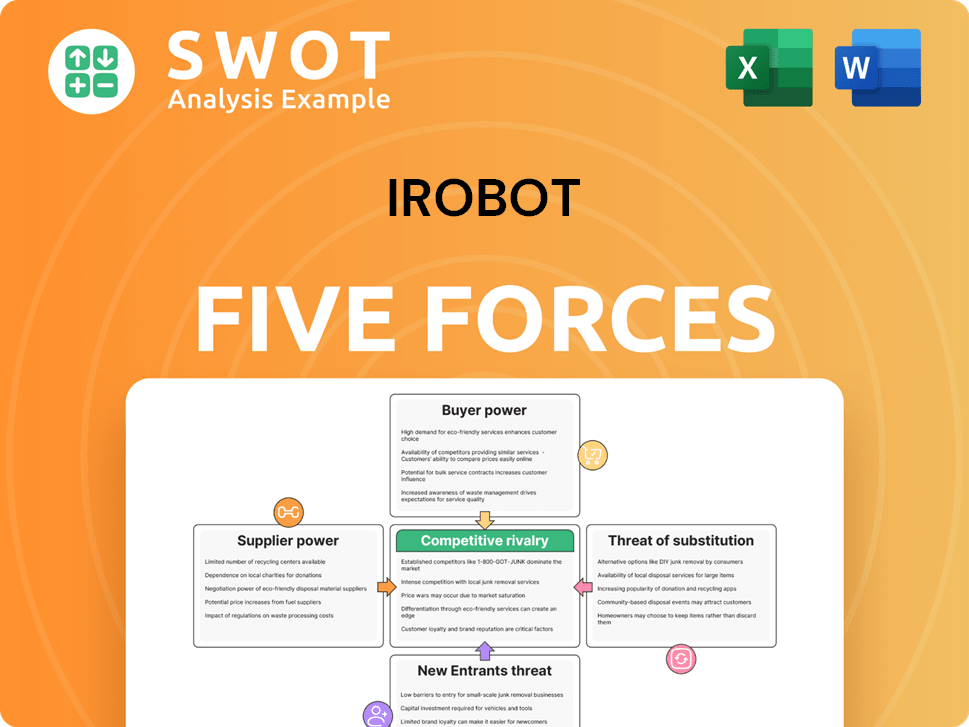
Related Blogs
- What are Mission Vision & Core Values of iRobot Company?
- What is Competitive Landscape of iRobot Company?
- What is Growth Strategy and Future Prospects of iRobot Company?
- What is Sales and Marketing Strategy of iRobot Company?
- What is Brief History of iRobot Company?
- Who Owns iRobot Company?
- What is Customer Demographics and Target Market of iRobot Company?
Disclaimer
All information, articles, and product details provided on this website are for general informational and educational purposes only. We do not claim any ownership over, nor do we intend to infringe upon, any trademarks, copyrights, logos, brand names, or other intellectual property mentioned or depicted on this site. Such intellectual property remains the property of its respective owners, and any references here are made solely for identification or informational purposes, without implying any affiliation, endorsement, or partnership.
We make no representations or warranties, express or implied, regarding the accuracy, completeness, or suitability of any content or products presented. Nothing on this website should be construed as legal, tax, investment, financial, medical, or other professional advice. In addition, no part of this site—including articles or product references—constitutes a solicitation, recommendation, endorsement, advertisement, or offer to buy or sell any securities, franchises, or other financial instruments, particularly in jurisdictions where such activity would be unlawful.
All content is of a general nature and may not address the specific circumstances of any individual or entity. It is not a substitute for professional advice or services. Any actions you take based on the information provided here are strictly at your own risk. You accept full responsibility for any decisions or outcomes arising from your use of this website and agree to release us from any liability in connection with your use of, or reliance upon, the content or products found herein.